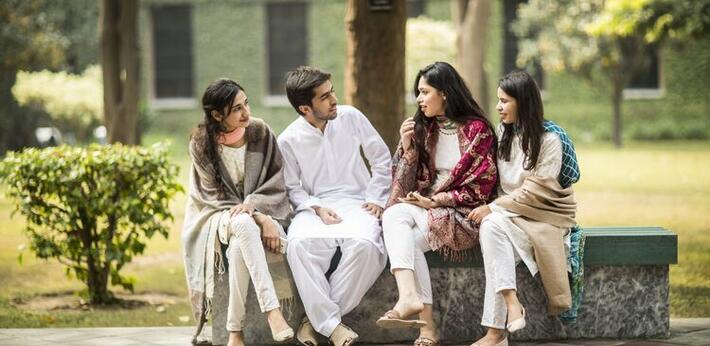You are here
Home ›05/08/2015
Rebooting education links with Iran
Iran’s agreement to increase the transparency of its nuclear energy programme in exchange for relaxed sanctions will provide a tremendous boost to the country’s economy and its contact with the outside world. While barriers to education cooperation remain, UK universities can use this opportunity to position themselves to absorb a resurgence of Iranian students and lay the groundwork for future partnerships in the world’s seventh largest higher education market.
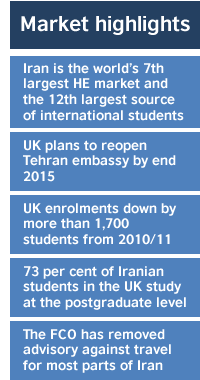
With a stroke of the pen on 14 July, Iran and the E3+31 greatly raised the prospects of greater cooperation and collaboration. The deal, formally known as the Joint Comprehensive Plan of Action (JCPOA), helps avoid confrontation and extends significant economic benefits to Iran. Under the agreement, the US and EU will gradually repeal sanctions currently stifling Iranian trade and commerce and unfreeze over US$100 billion in assets, equivalent to around one-quarter of the country’s total GDP in 2014. By some estimates, the removal of oil sanctions alone will result in an additional US$20 billion flowing into the economy annually.
Aside from brightening the country’s economic outlook, the deal also paves the way for normalised relations with the UK government. A day after the agreement was finalised, Foreign Secretary Philip Hammond announced that the UK will reopen its embassy in Tehran before the end of the year2. And on 25 July, the Foreign Commonwealth Office lifted its advisory against travel for most parts of Iran3.
These developments could have a notable impact on UK higher education institutions. Iranian student mobility to the UK collapsed after bilateral diplomatic ties were severed in late 2011, with study visa issuance plummeting by 58.6 per cent the following year (see chart). By 2014, there were 1,747 fewer study visas issued than in 2010. While part of the immediate decline may have been a symptom of lingering political tensions, the largest contributing factor was likely the difficulty in obtaining visas after the UK embassy was shuttered.
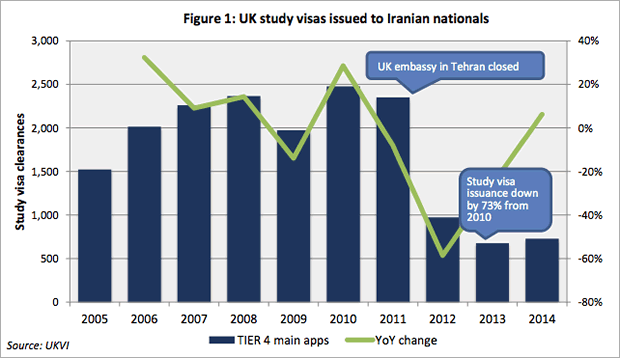
Since the UK embassy’s closure, prospective students must travel to either Turkey or the UAE in order to apply for visas and usually have to remain in country for several weeks while their applications are processed. By contrast, although Iranians applying for US student visas must pick up their visas outside of Iran, the initial application is processed online, and only the final interview is conducted abroad. Canada, which closed its Tehran embassy in 2012, employs a similar system. The relative ease with which American and Canadian visas can be obtained helps to explain why enrolments in these countries were spared the steep decline experienced by UK institutions (see Figure 2).
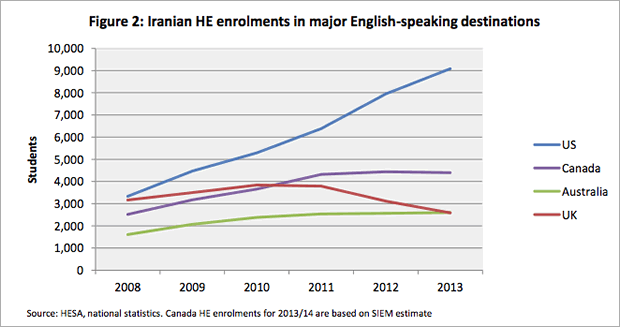
The resumption of full diplomatic ties and the reopening of embassies could to lead to a quick recovery in UK-bound students. If 2010 levels are a guide, an additional 1,700 new Iranian students per year may arrive in the UK, perhaps more if the previous growth trend resumes – in the five years prior to the embassy closure, Iranian enrolments in the UK grew at an average of 14.8 per cent per year.
Based on current enrolment statistics, demand will primarily be for post-graduate programmes (see Figure 3), with strong preference for engineering and computer science courses (see Figure 4). With the removal of oil sanctions, the popularity of courses related to energy engineering and petrochemicals is also likely to increase.
The majority of incoming Iranian students will likely pay their tuitions with little or no financial assistance. According to HESA data, the Iranian government did not provide scholarships for any students studying in the UK in the 2013/14 academic year, only around a quarter of Iran-domiciled students received any support from scholarships or other funding sources (see Figure 5). This is notable because the value of the Iranian currency has plummeted over the past decade, and sanctions in the banking sector force students to go through the black market to exchange funds, which often increases costs by 20 to 30 per cent. The removal of sanctions will ease this burden and make international education more affordable.
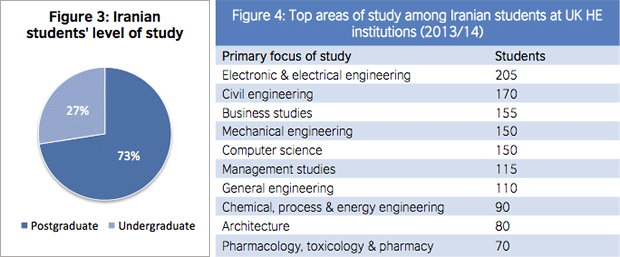
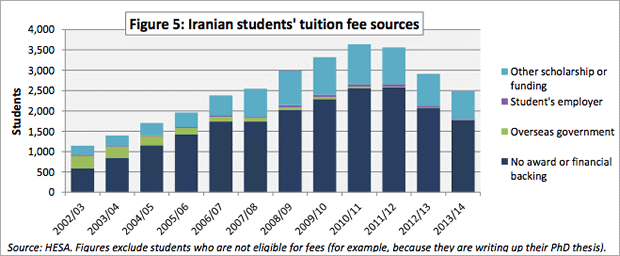
The long view
At first glance, Iran may appear to be a relatively small opportunity for the UK’s HE sector – there were only 2,585 Iran domiciled students studying in UK HEIs in 2013/14, compared to over 90,000 Chinese students. Yet the long-term potential of the Iran market could be considerable, particularly if Iran continues to rebuild linkages to the outside world.
In 2014 Iran had 4.6 million students enrolled in its colleges and universities, giving it the seventh largest tertiary sector in the world. Iran’s overall outbound student mobility has increased rapidly over the past decade, and as of 2013, Iran ranked as the world’s twelfth largest sending country, only narrowly trailing Russia, Nigeria, Vietnam and Malaysia.
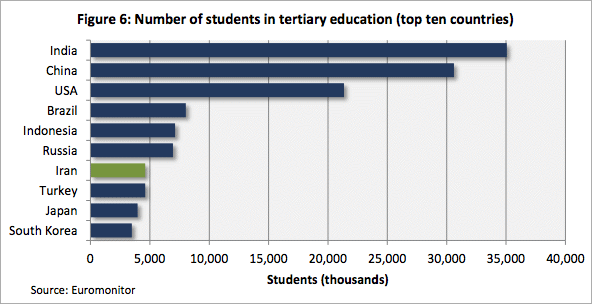
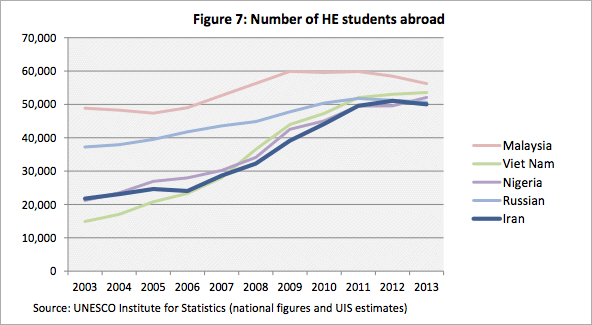
There are also encouraging signs that education policies are focusing more on promoting international ties. Mr Rouhani, who earned his PhD from Glasgow Caledonian University in 1999, has encouraged expanded links with foreign universities since he took office. He has also moved to reinstate some domestic faculty and students who were banned from campuses under the Mahmoud Ahmadinejad administration4. In the near term, contact with foreign institutions will likely take the form of more trips abroad by Iranian faculty, as well as invitations for foreign lecturers to visit. A relaxed political environment should also make it easier for Iranian students to study abroad.
Yet opportunities for more substantive cooperation may already be arriving. Iranian education officials report that they recently signed 2+1 PhD and 1+1 master’s programme agreements with Germany and France5. The US is also making inroads into the market. Although US-Iran relations remain complicated, education links between the two countries appear to be deepening, with the US Institute of International Education leading a delegation of senior education officials on a tour of 13 Iranian universities and research institutions a month before the nuclear deal was struck. UK institutions should take note of these trends and work to position themselves in the market sooner rather than later.
Balancing optimism and uncertainty
With the signing of the JCPOA, Iran has arrived at a moment of opportunity. The initial signs are promising, with commitments from Iran and other European countries to push ahead with bilateral visits immediately. Yet Iran will remain a challenging country for the international education sector. Although the climate has thawed somewhat over the past two years, certain elements within Iran remain opposed to contact with the West. Progress will come slowly.
Nonetheless, recent events provide an unprecedented opportunity for foreign education institutes to engage with Iran. As a first step, UK institutions can set a goal of restoring their enrolments to 2010/11 levels. There also exists a new and promising opportunity for UK institutions to explore opportunities for partnerships with Iranian institutions for UK student travel to Iran. But the past is perhaps only a narrow guide to future potential. A new era of economic growth and openness could allow UK education institutions to play an even more significant role in supporting the next generation of scientists, artists and entrepreneurs in building a peaceful and prosperous Iran.
The British Council’s Services for International Education Marketing team stands ready to help UK institutions refine their internationalisation strategies around the globe. Please get in touch if you would like to learn more.
Matt Durnin
Head of Research and Consultancy, SIEM East Asia
Matt.Durnin@britishcouncil.org.cn
Danny Whitehead
Director British Council Iran
Danny.Whitehead@britishcouncil.org
Fatemeh Ahmadi
Higher Education Manager, Iran
Fatemeh.Ahmadi@britishcouncil.org
Ottolie Wekezer
Regional Director, Education Marketing and Consultancy, South Asia
Ottolie.Wekezer@britishcouncil.org
1 The EU three (France, Germany and the UK) plus China, Russia and the US
2 Rowena Mason, ‘UK hopes to reopen embassy in Iran by end of year, says Philip Hammond’, The Guardian, 15 July 2015
3 Foreign travel advice, Iran, Gov.UK
4 Aisha Labi, “Iran eases constraints on academic contacts with West”, The Chronicle of Higher Education, 15 June 2014 (reprinted in the New York Times)
5 Meeting with senior Iranian education official, May 2015



